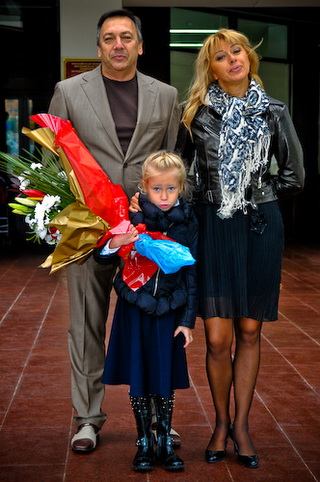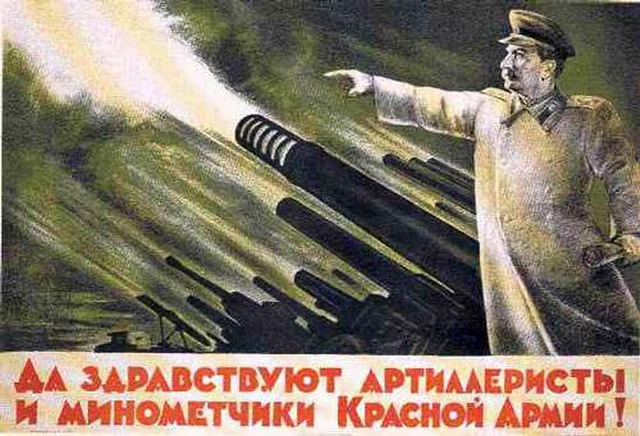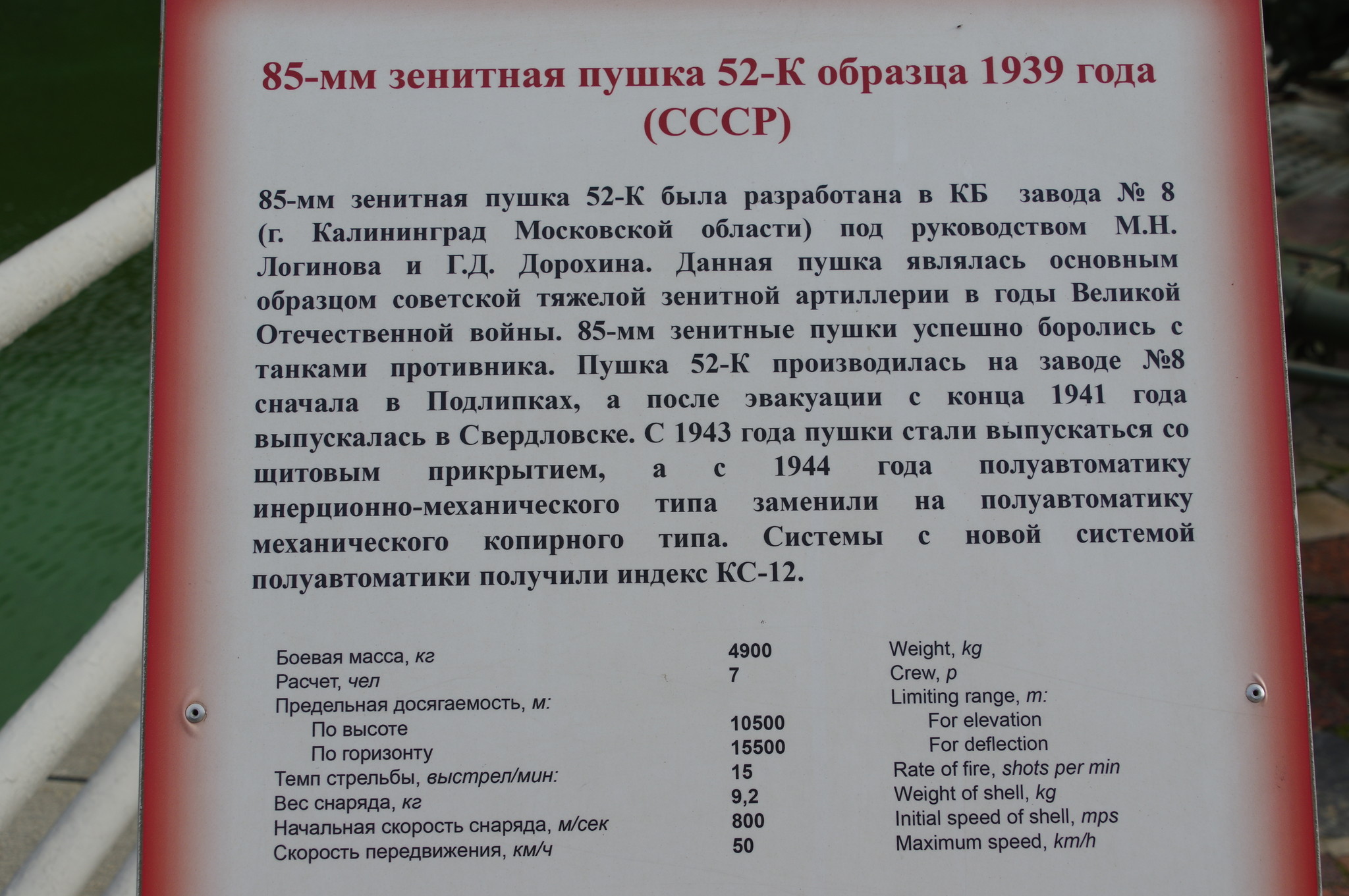85 mm anti-aircraft gun ks 12. Venevsky district - dangerous finds - artillery and cars
52-K or KS-12 (GAU Index - 52-P-365) - Soviet anti-aircraft gun of 85 mm caliber. The full official name of the gun is the 85 mm anti-aircraft gun of the 1939 model.

The 85-mm anti-aircraft gun was actively used in the Great Patriotic War in the role of both the anti-aircraft and anti-tank guns, and after its completion it was for a long time in service with the Soviet Army before the adoption of anti-aircraft missile systems.

The gun was developed by the design bureau of plant No. 8 in Kaliningrad, Moscow Region, on instructions from the GAU. Its predecessor was the 76-mm anti-aircraft gun of the 1938 model, created by Mikhail Nikolayevich Loginov, which was produced in a small series in 1938-1940. Due to the extremely tight deadlines allocated for the development of the new system, the leading designer G.D. Dorokhin decided to lay an 85-mm barrel on the platform of the 76-mm anti-aircraft gun of the 1938 model, using the shutter and semi-automatic of this gun.

In 1939, a new 85-mm anti-aircraft gun with the factory designation 52-K passed field tests, during which it became necessary to install a muzzle brake, increase the bearing surface of the gate wedge and breech nest.


To increase the accuracy of firing at air targets, the batteries of 85-mm anti-aircraft guns were equipped with PUAZO-3 artillery anti-aircraft fire control devices, which made it possible to solve the problem of meeting a shell and an aircraft. In addition to the POISO devices, to control the fire of the 85 mm anti-aircraft guns operating in the main directions, radar detection stations were also used.

The gun was also equipped with a mechanical installer of fuses designed by Lev Veniaminovich Lyulyev.

When the prototype was tested at the 24th NIZAP (research anti-aircraft artillery range at the station of Donguzskaya, Orenburg region) and the GAU ordered the plant a series of 20 guns, it turned out that this series was different from the prototype. OKB and the “chief” of anti-aircraft guns Grigory Dorokhin continued to improve the system.

It withstood all tests and was adopted as a 52-K hull anti-aircraft gun of the 1939 model. Kalinin plant was its only manufacturer. By the beginning of the war, the troops had 2630 of these most powerful domestic anti-aircraft guns.

In the fall of 1941, Plant No. 8 was evacuated to Sverdlovsk and Molotov (currently the city of Perm). The construction of the plant took place in extremely difficult conditions of the harsh Ural winter of 1941-1942, with frosts from minus 30 to 43 degrees and the absence of heating in the main workshops. Nevertheless, the work was in full swing. Dozens of platforms with factory property were unloaded, which accumulated at the railway entrance to the enterprise and at dead ends. As soon as the installation of equipment in the workshops was completed, the machines were immediately put into operation.

To heat the case, in the window openings of which there were no windows yet, and the roof was covered with tarpaulin, a steam locomotive was installed, but the cold was still terrible, the iron stoves and bonfires set in the spans did not help either. The emulsion froze, hands were numb. And not a word of reproach, complaint, whining. Workers, and among them more and more women, adolescents, silently, with harsh faces, built, assembled, produced parts, assemblies.

In February 1942, Kalinin citizens were no longer from the supplies brought with them, but from the parts manufactured in Sverdlovsk, they collected the first 118 anti-aircraft guns, completing the GKO mission.

Of course, every Kalinin understood that 118 guns were very few. The front needed many more guns. But dashing trouble began! In May, the plant completed the plan for the production of 85-mm anti-aircraft artillery by 136%.

The protracted war, the large losses of the army and civilian population from Hitler air raids urgently required a further sharp increase in the output of anti-aircraft artillery.

With the meager material and human resources that the Sverdlovsk plant owned by them. Kalinina, to solve this problem was the only one way - reducing the complexity and intensity of products.

The design of the 52-K gun was simplified, and at the same time the technology of its manufacture was improved.

In 1943, the advanced gun was successfully tested, and in February 1944, the gun, which received the factory index KS-12, went into mass production.

The first two letters of the index meant that the gun was created at the plant. Kalinina in Sverdlovsk.

Designed to combat enemy aircraft, to fire at airborne assaults, at live ground targets and enemy firing points, these guns were also successfully used to destroy fascist tanks. The 52-K task, which was unusual for anti-aircraft guns, was handled more successfully than other anti-tank guns of those years. With the armor-piercing shell attached to her, she could flash through the armor of all types of tanks that were in service with the German army until mid-1943. And when in 1942 G.D. Dorokhin was awarded the title of laureate of the State Prize, the award noted not only anti-aircraft, but also anti-tank guns.

Since 1943, instead of the barrel, consisting of a casing and a free pipe, they begin to establish a monoblock barrel. In the same year, guns began to be issued with shield covers.

In 1944, instead of a semi-automatic inertial-mechanical type, a semi-automatic mechanical (copy) type was introduced. During the Great Patriotic War, the gun served as the basis for the development of long-barreled tank guns D-5 and ZIS-S-53, which were installed on anti-tank self-propelled guns SU-85 and tanks T-34-85, KV-85 and IS-1. Some of the 52-K anti-aircraft guns, after being removed from service, were redone for peaceful use in mountainous areas as anti-avalanche guns. The 52-K cannon was transferred or sold to other countries to equip their armed forces.

The 52-K 85-mm anti-aircraft gun was installed in the Izmailovsky Park of Culture and Rest.

Back in the eighties of the twentieth century, the boys liked to turn the flywheels of horizontal and vertical aiming, deploying the gun barrel, but then the flywheels were welded.
|
By the end of the 30s, the leadership of the Soviet armed forces came to the conclusion that the predicted increase in the tactical and technical indicators of aviation in the next few years will lead to the moral aging of existing air defense weapons. The search began for projects of a more modern anti-aircraft gun with higher combat characteristics. The basis was taken 76.2 mm arr. 1938 they increased it and received an 85-mm anti-aircraft gun, 1939 models, KS-12.
 |
||
In many ways, similar arr. 1938, the new model had a multi-chamber muzzle brake, in smaller guns this was not found. The armor shield for gun calculation was supplied on an additional order. In 1939, the production of a new anti-aircraft gun mod. 1939 just started to be produced in Kaliningrad. When the Germans invaded the USSR, the plant was evacuated to the Urals where it remained until the end of the war. The anti-aircraft gun produced there arr. 1939 became the standard heavy air defense weapon of the Soviet Army. The more powerful 85-mm anti-aircraft gun, model 1944, KS 18, began to replace it only at the end of the war. Using the same shell as arr. 1939, anti-aircraft guns had higher combat performance due to increased charge. As well as for the German 88 mm guns, for arr. 39 and 44, it was possible to use anti-aircraft guns to combat tanks. The Soviet anti-aircraft guns were very successful in this, and the Germans used them along with their own guns of the 88 series under the name 85 mm Flak M.39 (g) and Flak M.44 (g). As well as the captured Soviet 76.2 mm guns, they were sent to Germany, for the needs of air defense. With the consumption of captured antiaircraft ammunition, anti-aircraft guns were gradually transferred to the standard 88 mm caliber for the Wehrmacht, becoming guns of the 85/88-mm Flak M.39 (r).

Soviet models of 1939 and 1944 were really good anti-aircraft guns. After the war, part of the gun until the 80s remained in the armies of the Warsaw Pact countries (except for the USSR); some of them were in Sudan, in Vietnam they were used during the war with the United States. Later, "modernized" anti-aircraft guns worked already with centralized fire control systems. The basic 85-mm model was used further in the development of subsequent generations of Soviet weapons. It was adapted as the main weapon of the SU-85 self-propelled assault artillery mount and anti-tank gun; there was also a towed model of the same gun.
|
At the end of the 30s, it became obvious that the rapid development of aviation will lead to significant problems in the future in case of confrontation between aviation and air defense forces. Thus, the existing air defense systems could not adequately guarantee sufficient efficiency. There was a need to give the army an anti-aircraft gun with a large radius of action, the gun had to be powerful enough to hit high-flying armored targets.
It was decided to take the 76.2 mm Rheinmetall gun as the basis and proceed from this when creating the anti-aircraft gun. This is what the designers of factory number 8 did in 1937-1938. The 76.2 mm gun had a large margin of safety inherent in the casing, breech and carriage. As a result, a cannon of a new at that time (not counting the appearing single instances) 85-mm caliber was developed. The 85 mm anti-aircraft gun of the 1939 model is also known as KS-12. The new gun had good characteristics - 800 m / s of the initial velocity of the projectile weighing 9.2 kg and a range of 10.5 km - allowed the new anti-aircraft gun to very effectively fight against armored and high-flying targets. The gun had an inertial semi-automatic shutter. Shooting from an anti-aircraft gun at ground armored targets was also to show high results. Thus, even before the outbreak of hostilities, the KS-12 anti-aircraft gun went into mass production. During the use of the gun in combat conditions, it was decided to equip the anti-aircraft gun with an armored shield. Instead of a barrel, consisting of a free pipe with a casing, a monoblock barrel was introduced, a shutter with a semi-automatic copy type was used. The calculations of the guns used semi-automatic anti-aircraft fire control devices PUAZO-2 arr. 1934 or POISO-3 arr. 1940 and stereoscopic range finder. And since 1943, the radar tracking stations RUS-2 Redut went into batteries.
Mass production of the KS-12 continued until 1944, when it was replaced by an even more powerful 85-mm anti-aircraft gun (KS-18), which also became the main means of air defense of the Red Army. From the previous modification, the new one had a longer monoblock barrel and increased powder charge. A new cradle was developed for the gun, a balancing mechanism and a shutter with a semi-automatic copy type. It had an automatic fuse installer, which allowed to accelerate the preparation of the shot
Like the Germans, who from the middle of the war increasingly used anti-aircraft guns as the main weapons of tanks, our designers also appreciated the great benefits of such a move. The ZIS-S-53 cannon has proven itself during the war.
During the war, the Germans fell into the hands of many serviceable guns, which in their characteristics were similar to the German 88-mm anti-aircraft gun. Under the designations 8.5-cm Flak M.39 (r) and 8.5-cm Flak M.44, our anti-aircraft guns were very actively used by the Germans.
The 85-mm anti-aircraft gun "survived" the war and for some time it was in service with the Soviet Army. A certain amount was delivered to the socialist countries, including Vietnam, where they were tasked with fighting American aircraft.
The 85 mm anti-aircraft gun of the 1939 model
| Caliber | 85 mm |
| Travel weight | 4220 kg |
| Weight in combat | 3057 kg |
| Barrel length | 55.2 caliber |
| Dimensions: | |
| height | 2.25 m |
| length (camping) | 4.7 m |
| width | 2.15 m |
| Gun rotation | 360 degrees |
| Range of defeat (in height) | 10.5 km |
| Range of defeat | 15.5 km |
| Projectile weight | 9.2 kg |
| Muzzle velocity | 800 m / s |
| Rate of fire | up to 15 rounds / min |
The 85 mm anti-aircraft gun of 1944
85 mm 90-K mount
85-mm universal deck mount 90-K model 1941
Classification
Production history
Operation history
| It was in service | USSR Navy |
| Years of operation | 1942 - p.t. g. |
| It was set to | KR pr. 26bis, EM pr. 30K and 30bis, SKR pr. 29, BTSC pr. 73K |
| Wars and conflicts | The Second World War |
Gun characteristics
Shell characteristics

Design
To increase the air defense of ships in the interwar years, the USSR Navy upgraded the first generation of 76.2 mm artillery units (AU). It was decided to switch to a larger 85 mm caliber. On the machines of 76-mm gun mounts installed 85-mm barrels of full-time army guns, while retaining all the other main elements of ship installations.

Installation 92-K
85 mm universal deck mount mod. 1941 90-K was designed in the design bureau of plant number 8 and was an improved version of the 76-mm AU 34-K with a swinging part from the 85-mm army anti-aircraft gun mod. 1939
Production and Testing
The prototype 90-K was tested in July-August 1941 and was recommended for gross production based on the test results.
With the outbreak of war, Plant No. 8 was evacuated from Podlipok to Sverdlovsk, where the gross output of 90-K artillery mounts was organized.
Ship installation tests took place in the Pacific Fleet in April 1944.
Further development
A further development of this installation is the 85 mm twin universal installation mod. 1946 92-K.
Descriptions and characteristics of the gun
Trunk 90-K consists of a free pipe, casing and breech. Vertical wedge shutter with spring semi-automatic. According to the 1942 project, it was planned to install SSSP-3 electric remote drives, but electric motors were not installed on serial gun mounts, and all guidance drives were manual.
The performance characteristics of the 90-K
The installation is closed on three sides by an armor shield. The thickness of the shield armor is 8-12 mm.

1-shot UBR-365P with a projectile BR-365P;
2-shot UBR-365 with a projectile BR-365;
3-shot UBR-365K with a projectile BR-365K;
4-shot UO-365K with an O-365K shell
Ammunition
The ammunition of the ship’s 85 mm gun included the following types of shells
Fire control devices
The 90-K installation had two MO sights. The characteristics of the sight are presented in the table.
Operation history
Officially, the 90-K gun mount was put into service on July 25, 1946. It was located on the Kaganovich and Kalinin cruisers of Project 26bis (8 gun mounts), destroyers of Project 30K and 30bis, on part of the patrol ships of Project 29, large hunters of Project 122 and other ships. In the 70s, the construction of new batteries of the Vladivostok Defensive Region (VLOR) partially used 85-mm 90-K universal guns.
Artillery
Artillery
It is well known about the units of Soviet anti-aircraft gunners defending Venev. And, unfortunately, nothing is known about the field artillery of the rifle units of the Red Army and the 115th NKVD regiment.
85-mm anti-aircraft gun 52-K mod. 1939 (USSR)
On the morning of November 21, the 2nd battery of the 702nd anti-tank artillery regiment arrived from Tula to Venev, armed with 85-mm anti-aircraft guns and took up positions near the road on the western outskirts of Venev. On this day, they shot down 2 enemy aircraft, both pilots were captured. At noon, 21 batteries were transferred to the region of Semyany, where 2 more enemy aircraft were shot down. On the morning of November 22, she was relocated to the Venev area.
From the memoirs of S.P. Rodionov: "The shell of an 85-mm anti-aircraft gun pierced any German tank of that time on two sides at a distance of up to 1.5 kilometers."

85 mm anti-aircraft gun against the background of the panorama of Venev. November-December 1941
37-mm automatic gun 61-K (USSR)
Calculation of 7 people
Maximum rate of fire 160-170 rounds / min
Reach in height - 6500 m
The 16th battery of the 732th anti-aircraft artillery regiment under the command of Lieutenant S.P. Zelyanin and political instructor I.S. Polikarpov, consisting of four 37-mm guns and 66 fighters and commanders, hastily moved from Tula to the Venev area on November 22, she was attacked by an air enemy 4 times, during which she shot down 2 planes. On November 24, the battery took up a position on the eastern outskirts of Venev on a high hill beyond the Pushkarskaya Sloboda.

In the center is a 37 mm anti-aircraft gun. Supposedly
venev photo. November-December 1941
From the memoirs of S.P. Rodionov: "The 37-mm anti-aircraft gun / MZA / as part of the anti-aircraft and anti-tank artillery regiments mainly solved the tasks of air cover of our ground troops in connection with the domination of enemy aircraft. Effectively fight against enemy tanks due to low penetration she couldn’t armor. The battles near Orel, Mtsensk, Tula showed that the enemy’s tanks fearlessly went to this material part and, as a rule, destroyed it with caterpillars and fire, because the 37-mm shell did not damage it. "
20-mm automatic anti-aircraft gun Flak 38 (Germany, 1940-1945)
Calculation of 7 people
Rate of Fire 220 rds / min
Reach in height - 4400 m
Horizontal Range - 5700 m

Combat crew Flak 38 against the backdrop of Venev, end of November 1941,
from Albert Frank album
A few more pictures from the album of Albert Frank taken together with the Vienna photo, probably they are also from our places.
 |
 |
 |
 |
One of the German anti-aircraft guns was installed on a hill near the Zaraisk bridge. During the retreat, they did not have time to pick him up. The Red Army disarmed the anti-aircraft gun by removing the barrel and dropping it into the river, and the carriage, rotating 360 degrees, was left in the same place. Venevskaya children have long used it as a carousel.
88-mm anti-aircraft gun Flak 36/37 (Germany, 1935-1945)
Rate of Fire 15-20 rds / min
Residents of Venev recalled that during the retreat of German troops, one of the cannons on a four-wheeled carriage bogged down across the Venevka river near the village of Berezovo. Perhaps it was an 88 mm anti-aircraft gun. The trophy team already pulled it out.
105 mm heavy gun s.K 18 (Germany, 1934-1945)
Range up to 18 km
Krupp truck L3 H 63 (Germany) 1933-1938
|
|








